New products
Vol. 226 No. 11 Screen system for sandface completion The new Baker Oil Tools DIRECT PAK gravel-pack screen system prevents hole instability in hor
Screen system for sandface completion
Heliportable slickline units 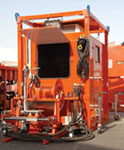 AlMansoori Specialized Engineering has launched the first lightweight offshore slickline units that are transportable by helicopter. Constructed of aluminum and weighing less than 3,000 lb, the two-man units are air-conditioned and pressurized for working in harsh weather conditions. The units have a Zone 2 fire safety rating.
Work area camera system A machine-mounted closed-circuit vision system developed specifically for rugged applications and environments has been introduced by Caterpillar Electronics and Electrical Systems. The Work Area Vision System (WAVS) is designed for installation on any machine and for ease of use by operators at any level. The system can provide operators with views from up to three cameras using switching algorithms. The cameras are designed to withstand vibration, pressure washing and adverse environmental conditions. The display features a 7-in. color thin film transistor LCD display incorporating auto-sense illumination to adjust to changing light conditions. Camera features panoramic (115°) or narrow (78°) views, photochromic lens that darkens in ultraviolet light exposure, and internal heater for removal of condensation, snow and ice. A vertical universal mount is standard, and a horizontal mount is also available.
Subsea navigation system 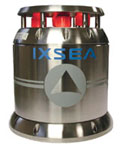 iXSea has developed PHINS 6000, a dedicated subsea Inertial Navigation System (INS). The system is a subsea application for iXSea’s standard setting PHINS INS, an inertial system at the heart of many AUV navigation systems. PHINS 6000 can provide subsea vessels with position (X, Y, Z) true-heading, attitude, speed and heave information. It is based on fiber optic gyroscope (FOG) technology coupled with a digital signal processor, which runs a Kalman filter especially developed for marine applications. PHINS 6000 targets the AUV and ROV markets, where off-the-shelf INS systems are in demand. It is a versatile system that connects to different aiding sensors such as: GPS receiver (any type, single antenna); Doppler Velocity Log; acoustic positioning systems such as USBL or LBL and Depth. Whatever the number of sensors, the system will select the aiding data whenever it is available and optimizes its settings accordingly.
Reconfigurable computing technology Silicon Graphics introduced a hardware solution based on SGI Reconfigurable Application-Specific Computing (RASC) technology, capable of increasing application performance by hundreds of times over conventional systems. RASC technology enables greatly improved scalability and bandwidth for data-intensive applications critical to oil and gas exploration and other data-dependent industries. The reconfigurable computing technology is available as an add-in module that seamlessly operates with SGI’s Intel Itanium 2 processor-based servers and visualization systems. Reprogramming a processor usually requires high levels of expertise, but SGI’s RASC solution is specifically designed to ease the implementation of Field-Programmable Gate Array (FPGA) technology by enhancing performance and optimizing ease-of-deployment. These include an FPGA-aware version of the Gnu Debugger (GDB) built on the current GDB command set, allowing simultaneous debugging of both the application and the FPGA; an abstraction layer that enables serial or parallel FPGA scaling; and a RASC API and core services library that provides tools to develop reconfigurable computing elements in a multi-user, multi-processing environment. The FPGA hardware is connected directly into the NUMAlink fabric, providing low-latency, high-bandwidth and tight integration of application-specific and general-purpose computing elements in a single shared-memory environment. Scalability is therefore virtually limitless.
Motor bit series brochure 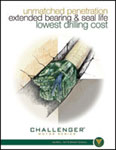 Varel International has released a new eight-page brochure about the Challenger Motor Series, the company’s line of tungsten carbide insert (TCI) and steel tooth bits. The brochure includes comprehensive information about the bits’ cutting structures, designed to maximize high penetration rates, steerability and durability. Technical information is included about Varel’s High Energy Tumbling technology, designed to reduce insert breakage and deliver greater penetration rates. Optional features include diamond enhanced cutting structures, shirttails and stabilization inserts for added gage protection and extended bit life. Additional information describes the journal bearing package for sizes up to 13-1/2 in., and roller bearing for sizes 14-1/2 in. and larger, as well as a product availability chart for sizes ranging from 3-7/8 in. to 17-1/2 in.
Bevel gear operators Flowserve Corp., a provider of fluid motion and control products and services, has launched the Limitorque Actuation Systems MT series of bevel gear operators. They are a combination of a bevel gear operator torque housing with a new thrust base design. The series is suited for torque-seated valve applications and applications involving elevated process temperatures. MT series bevel gears and thrust base housings are made of ductile iron, and features robust thrust bearings and drive sleeve/ stem nut design. These combine as a rugged bevel gear operator for handling the seating and unseating forces of high-pressure gate and globe valves. The operator stem nut is shouldered in the drive sleeve to capture thrust forces within the thrust housing without transferring those forces to the torque housing. Available in torque ranges to 8,000 ft-lb and thrust ranges to 325,000 lb., the MT series provides high efficiency and strong design for every application.
Production management system A new brochure available from Baker Oil Tools details how the EQUALIZER Production Management System prevents water and gas coning in sandstone formations and prevents excessive water breakthrough in naturally fractured carbonate formations in long horizontal and highly deviated wells. The system creates a uniform production profile and virtually eliminates screen-to-wellbore annular flow, reducing the need for gravel packing and increasing screen life. The uniform flow profile enhances oil recovery by reducing water and gas coning, screen plugging, and erosion.
Oil, politics and nations The Politics of the Global Oil Industry: An Introduction is a new book that provides a broad, clearly written overview of how the world’s most crucial commodity is exploited, efficiently and inefficiently, by seven modern oil exporters. The authors, Toyin Falola and Ann Genova, chose countries (Iraq, Mexico, Nigeria, Norway, Russia, Saudi Arabia and Venezuela), that have both vast oil reserves and are major exporters.
|


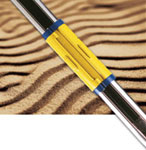 The new Baker Oil Tools DIRECT PAK gravel-pack screen system prevents hole instability in horizontal open-hole gravel packs and annular bridging during long-interval cased-hole fracs. The screen system’s design provides an additional flow path for slurry transport, should annular bridging occur while packing and maximum mechanical strength while minimizing the OD. The spiral design helps centralize the screen and evenly distribute sand slurry to reduce the possibility of annular voids. The system is built on EXCLUDER2000 screen technology.
The new Baker Oil Tools DIRECT PAK gravel-pack screen system prevents hole instability in horizontal open-hole gravel packs and annular bridging during long-interval cased-hole fracs. The screen system’s design provides an additional flow path for slurry transport, should annular bridging occur while packing and maximum mechanical strength while minimizing the OD. The spiral design helps centralize the screen and evenly distribute sand slurry to reduce the possibility of annular voids. The system is built on EXCLUDER2000 screen technology.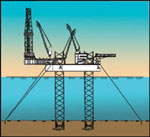 Originally designed to enhance the deepwater capability and service life of shallow-water jackups, it also improves storm survivability. The Storm Lashing System uses radially spaced mooring lines that connect suction pile or vertical load anchors (VLA) to the jackup hull or legs at 20° to 40° angles, and a static tensioning mechanism to ensure taut lines. Unlike semi-submersibles, the system can be installed after the unit is on location – it does not need to be deployed before the jackup is on site. The concept involves an engineering evaluation of the existing rig or new-build design, followed by selection of the correct configuration to optimize the design parameters. These might include: stresses in the leg members; storm holding capacity of the elevating pinions of the jacking system; storm holding capacity of the leg-to-hull locking system, if so equipped; allowable leg footing soil reactions; preload capacity; and overturning. Depending on client preferences, the mooring lines may be connected to strong points on the hull, jack houses, or additional jacking units that climb the leg chords.
Originally designed to enhance the deepwater capability and service life of shallow-water jackups, it also improves storm survivability. The Storm Lashing System uses radially spaced mooring lines that connect suction pile or vertical load anchors (VLA) to the jackup hull or legs at 20° to 40° angles, and a static tensioning mechanism to ensure taut lines. Unlike semi-submersibles, the system can be installed after the unit is on location – it does not need to be deployed before the jackup is on site. The concept involves an engineering evaluation of the existing rig or new-build design, followed by selection of the correct configuration to optimize the design parameters. These might include: stresses in the leg members; storm holding capacity of the elevating pinions of the jacking system; storm holding capacity of the leg-to-hull locking system, if so equipped; allowable leg footing soil reactions; preload capacity; and overturning. Depending on client preferences, the mooring lines may be connected to strong points on the hull, jack houses, or additional jacking units that climb the leg chords. The book describes how the three large historical shifts occurred among who were able, with more or less success, to control oil prices. First there were the international oil companies, which from the 1800s until the 1950s controlled virtually all the petroleum market outside of Russia and China. “New to the oil companies, oil-rich countries did not always take the necessary steps to maintain control” over their oil, “creating a long-standing struggle between the two.” Then, with the formation of OPEC, the price-setting power shifted toward countries that had previously been, for the most part, economically insignificant. OPEC succeeded in controlling price, largely by controlling production among its members. Finally, as OPEC nations began to fragment and compete more and more with each other and with larger non-OPEC producers, a third shift carried the pricing power into the hands of brokers and traders, such as the NYMEX and the UK’s International Petroleum Exchange. The Politics of the Global Oil Industry presents a very readable country-by-country breakdown of the seven major exporters, their resources, history, petroleum infrastructure, and political dynamics. This is a very fine reference source and overview of the international situation today, and how each nation’s decisions, for good and bad, affected their current status. Extensive bibliographies and recommended readings are included for each section.
The book describes how the three large historical shifts occurred among who were able, with more or less success, to control oil prices. First there were the international oil companies, which from the 1800s until the 1950s controlled virtually all the petroleum market outside of Russia and China. “New to the oil companies, oil-rich countries did not always take the necessary steps to maintain control” over their oil, “creating a long-standing struggle between the two.” Then, with the formation of OPEC, the price-setting power shifted toward countries that had previously been, for the most part, economically insignificant. OPEC succeeded in controlling price, largely by controlling production among its members. Finally, as OPEC nations began to fragment and compete more and more with each other and with larger non-OPEC producers, a third shift carried the pricing power into the hands of brokers and traders, such as the NYMEX and the UK’s International Petroleum Exchange. The Politics of the Global Oil Industry presents a very readable country-by-country breakdown of the seven major exporters, their resources, history, petroleum infrastructure, and political dynamics. This is a very fine reference source and overview of the international situation today, and how each nation’s decisions, for good and bad, affected their current status. Extensive bibliographies and recommended readings are included for each section.
